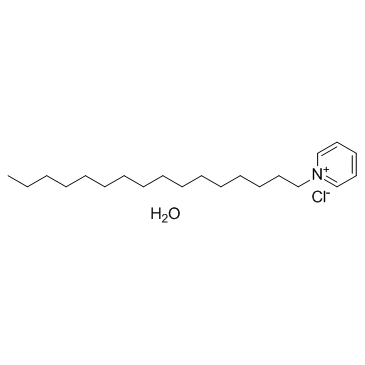Cetylpyridinium chloride monohydrate

Cetylpyridinium chloride monohydrate structure
|
Common Name | Cetylpyridinium chloride monohydrate | ||
|---|---|---|---|---|
| CAS Number | 6004-24-6 | Molecular Weight | 358.001 | |
| Density | N/A | Boiling Point | N/A | |
| Molecular Formula | C21H40ClNO | Melting Point | 81-84 °C | |
| MSDS | Chinese USA | Flash Point | N/A | |
| Symbol |


GHS06, GHS09 |
Signal Word | Danger | |
|
Exosomes: novel effectors of human platelet lysate activity.
Eur. Cell. Mater. 28 , 137-51; discussion 151, (2014) Despite the popularity of platelet-rich plasma (PRP) and platelet lysate (PL) in orthopaedic practice, the mechanism of action and the effectiveness of these therapeutic tools are still controversial. So far, the activity of PRP and PL has been associated wit... |
|
|
Impact of lipid dynamic behavior on physical stability, in vitro release and skin permeation of genistein-loaded lipid nanoparticles.
Eur. J. Pharm. Biopharm. 88(1) , 40-7, (2014) The aim of this study was to develop lipid nanoparticles to deliver genistein (GEN) to deeper skin layers. To do so, the impact of lipid dynamic behavior (nanoparticle flexibility) on stability, release and skin permeation studies was verified. GEN-loaded sol... |
|
|
Effect of silver nanoparticles on human mesenchymal stem cell differentiation.
Beilstein J. Nanotechnol. 5 , 2058-69, (2014) Silver nanoparticles (Ag-NP) are one of the fastest growing products in nano-medicine due to their enhanced antibacterial activity at the nanoscale level. In biomedicine, hundreds of products have been coated with Ag-NP. For example, various medical devices i... |
|
|
SIRT1 directly regulates SOX2 to maintain self-renewal and multipotency in bone marrow-derived mesenchymal stem cells.
Stem Cells 32(12) , 3219-31, (2014) SOX2 is crucial for the maintenance of the self-renewal capacity and multipotency of mesenchymal stem cells (MSCs); however, the mechanism by which SOX2 is regulated remains unclear. Here, we report that RNA interference of sirtuin 1 (SIRT1) in human bone mar... |
|
|
Donor-matched mesenchymal stem cells from knee infrapatellar and subcutaneous adipose tissue of osteoarthritic donors display differential chondrogenic and osteogenic commitment.
Eur. Cell. Mater. 27 , 298-311, (2014) Cell-based therapies have recently been proposed for the treatment of degenerative articular pathologies, such as early osteoarthritis, with an emphasis on autologous mesenchymal stem cells (MSCs), as an alternative to terminally differentiated cells. In this... |
|
|
Peripheral antinociception and anti-inflammatory effects of sulphated polysaccharides from the alga Caulerpa mexicana.
Basic Clin Pharmacol Toxicol. 115(4) , 335-42, (2014) Sulphated polysaccharides from marine algae are widely used in biotechnological and pharmaceutical areas. In this study, we evaluated the effects of sulphated polysaccharides from the green marine alga Caulerpa mexicana (Cm-SPs) in nociceptive and inflammator... |
|
|
Improvement of dual-leached polycaprolactone porous scaffolds by incorporating with hydroxyapatite for bone tissue regeneration.
J. Biomater. Sci. Polym. Ed. 25(17) , 1986-2008, (2014) Polycaprolactone (PCL)/hydroxyapatite (HA) composite scaffolds were prepared by combining solvent casting and salt particulate leaching with a polymer leaching technique. The hydrophilicity of the dual-leached scaffold was improved by alkaline (NaOH) treatmen... |
|
|
Novel matrix proteins of Pteria penguin pearl oyster shell nacre homologous to the jacalin-related β-prism fold lectins.
PLoS ONE 9(11) , e112326, (2014) Nacreous layers of pearl oyster are one of the major functional biominerals. By participating in organic compound-crystal interactions, they assemble into consecutive mineral lamellae-like photonic crystals. Their biomineralization mechanisms are controlled b... |
|
|
The stem cell potential and multipotency of human adipose tissue-derived stem cells vary by cell donor and are different from those of other types of stem cells.
Cells Tissues Organs 199(5-6) , 373-83, (2015) Human adipose tissue-derived mesenchymal stem cells (AT-MSCs) from various sites are applied in tissue engineering and cell therapy. The condition of AT-MSCs depends on the donor's age, body mass index (BMI), and gender. AT-MSCs from 66 human donors were anal... |
|
|
Ostericum koreanum Reduces LPS-Induced Bone Loss Through Inhibition of Osteoclastogenesis.
Am. J. Chin. Med. 43 , 495-512, (2015) The roots of Ostericum koreanum (OK) Maximowicz have traditionally been used to produce an herbal medicine reported to possess anti-inflammatory, anti-oxidant, antimicrobial, and antitumor activities; however, its effect on bone metabolism has not yet been re... |